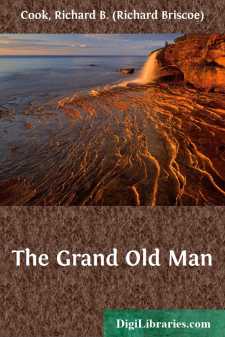Categories
- Antiques & Collectibles 13
- Architecture 36
- Art 48
- Bibles 22
- Biography & Autobiography 813
- Body, Mind & Spirit 142
- Business & Economics 28
- Children's Books 16
- Children's Fiction 13
- Computers 4
- Cooking 94
- Crafts & Hobbies 4
- Drama 346
- Education 46
- Family & Relationships 57
- Fiction 11829
- Games 19
- Gardening 17
- Health & Fitness 34
- History 1377
- House & Home 1
- Humor 147
- Juvenile Fiction 1873
- Juvenile Nonfiction 202
- Language Arts & Disciplines 88
- Law 16
- Literary Collections 686
- Literary Criticism 179
- Mathematics 13
- Medical 41
- Music 40
- Nature 179
- Non-Classifiable 1768
- Performing Arts 7
- Periodicals 1453
- Philosophy 64
- Photography 2
- Poetry 896
- Political Science 203
- Psychology 42
- Reference 154
- Religion 513
- Science 126
- Self-Help 84
- Social Science 81
- Sports & Recreation 34
- Study Aids 3
- Technology & Engineering 59
- Transportation 23
- Travel 463
- True Crime 29
The Grand Old Man
Description:
Excerpt
CHAPTER I
ANCESTRY AND BIRTH
All history, says Emerson, "resolves itself into the biographies of a few stout and earnest persons." These remarks find exemplification in the life of William Ewart Gladstone, of whom they are pre-eminently true. His recorded life, from the early period of his graduation to his fourth premiership, would embrace in every important respect not only the history of the British Empire, but very largely the international events of every nation of the world for more than half a century.
William Ewart Gladstone, M.P., D.C.L., statesman, orator and scholar, was born December 27, 1809, in Liverpool, England. The house in which he was born, number 62 Rodney Street, a commodious and imposing "double-fronted" dwelling of red brick, is still standing. In the neighborhood of the Rodney Street house, and a few years before or after the birth of William E. Gladstone, a number of distinguished persons were born, among them William Roscoe, the writer and philanthropist, John Gibson, the sculptor, Doctor Bickersteth, the late Bishop of Ripon, Mrs. Hemans, the poetess, and Doctor James Martineau, Professor of Mental and Moral Philosophy in Manchester New College, and the brother of Harriet Martineau, the authoress.
The Gladstone family, or Gledstanes, which was the original family name, was of Scottish origin. The derivation of the name is obvious enough to any one familiar with the ancestral home. A gled is a hawk, and that fierce and beautiful bird would have found its natural refuge among the stanes, or rocks, of the craggy moorlands which surround the "fortalice of gledstanes." As far back as 1296 Herbert de Gledstane figures in the Ragman Roll as one of the lairds who swore fealty to Edward I. His descendants for generations held knightly rank, and bore their part in the adventurous life of the Border. The chief stock was settled at Liberton, in the upper part of Clydesdale. It was a family of Scottish lairds, holding large estates in the sixteenth century. The estate dwindled, and in the beginning of the seventeenth century passed out of their hands, except the adjacent property of Authurshiel, which remained in their possession for a hundred years longer. A younger branch of the family—the son of the last of the Gledstanes of Arthurshiel—after many generations, came to dwell at Biggar, in Lanarkshire, where he conducted the business of a "maltster," or grain merchant.
Here, and at about this time, the name was changed to Gladstones, and a grandson of the maltster of Biggar, Thomas Gladstones, settled in Leith and there became a "corn-merchant." He was born at Mid Toftcombs, in 1732, and married Helen Neilson, of Springfield. His aptitude for business was so great that he was enabled to make ample provision for a large family of sixteen children. His son, John Gladstone, was the father of William E. Gladstone, the subject of our sketch.
Some have ascribed to Mr. Gladstone an illustrious, even a royal ancestry, through his father's marriage....


